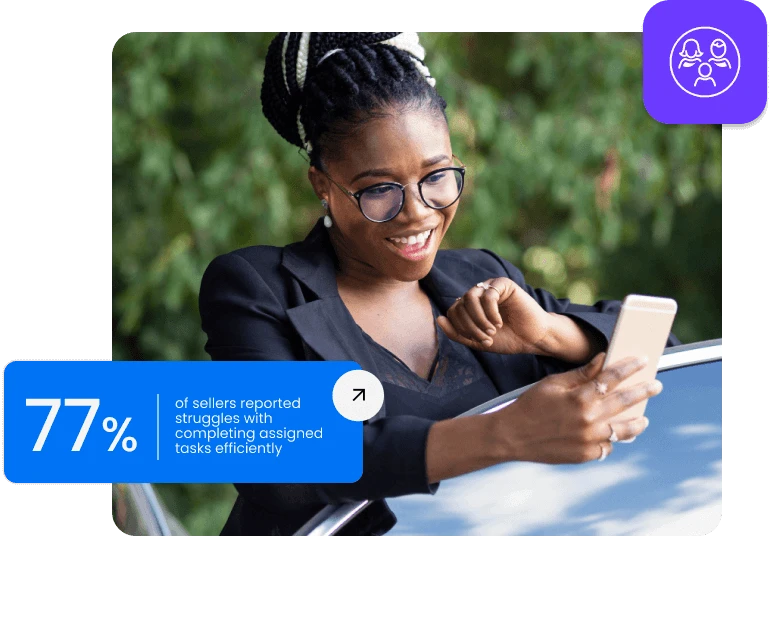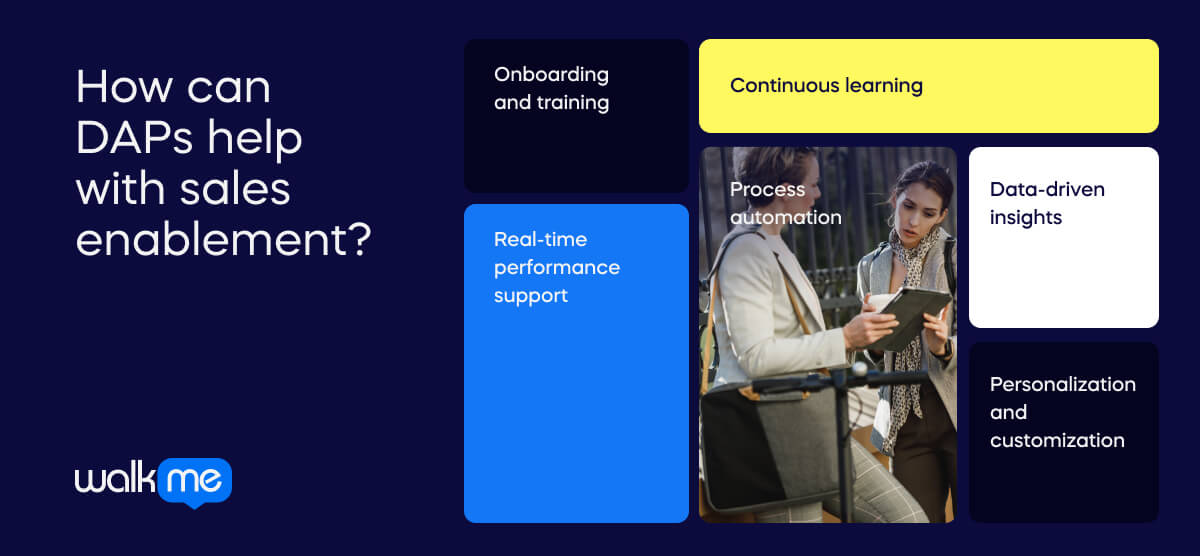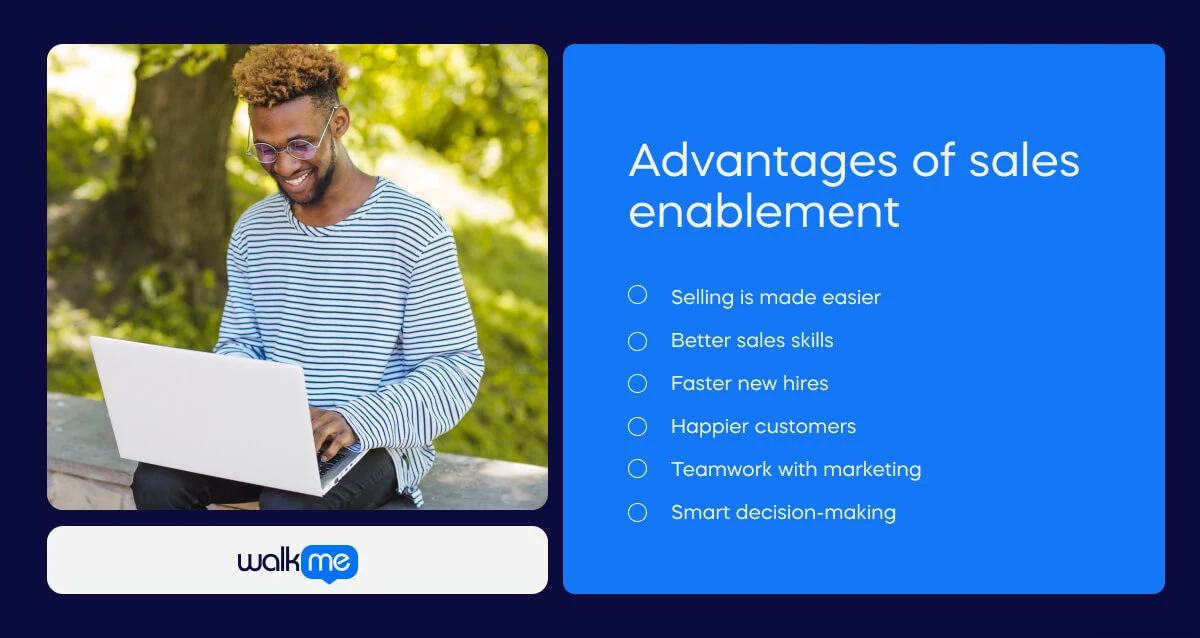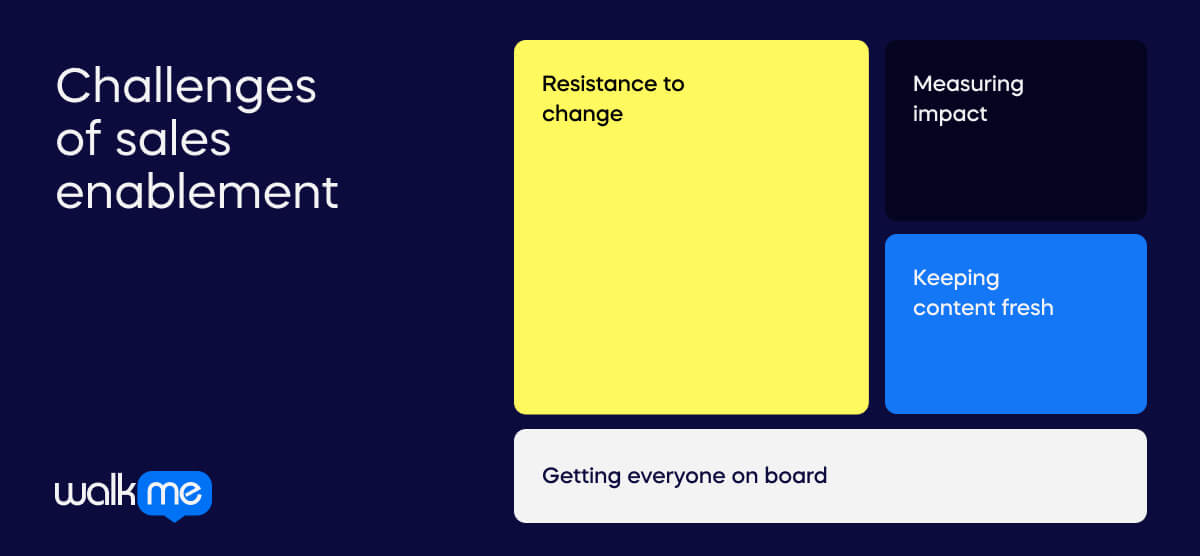Sales enablement

Table of contents
Sales enablement is about giving sales teams what they need to do their job well. This includes training, tools, and support to engage effectively with customers and close deals. Investing in sales enablement helps sales teams work better. It ultimately leads to improved results and more revenue. Research from Gartner demonstrates that ensuring effective enablement is paramount. Despite sales organizations investing in initiatives, 77% of sellers reported struggles with completing assigned tasks efficiently. Here’s what sales enablement involves: Training: Teaching sales teams about products, sales techniques, and how to talk to customers. Content: Creating materials like presentations and case studies to help salespeople and meet customers’ needs. Technology: Using tools like CRM systems to track performance and make sales processes smoother. Coaching: Offering ongoing help and guidance to improve sales performance. Collaboration: Working closely with the marketing team to ensure everyone is on the same page.
How can DAPs help with sales enablement?

Digital adoption platforms – DAPs for short – play a special role in making sales enablement effective. Let’s find out how WalkMe, a powerful DAP, can help in various situations:
Onboarding and training
- WalkMe guides new sales reps step-by-step in using tools like CRM systems
- Customized Smart Walk-Thrus introduce important features smoothly
- New hires learn quickly, making them productive faster.
Continuous learning
- The DAP provides guidance and training materials as sales teams progress
- Real-time tips are given exactly when employees need them
- Sales reps stay updated on product features and sales tactics
Process automation
- The platform automates repetitive tasks with ease
- This feature gives sales employees more time for important work
- Automated workflows make the sales team more efficient
Real-time performance support
- WalkMe offers immediate help when people interact with software
- Useful tips appear right within the CRM or sales apps
- These SmartTips speed up understanding and productivity levels
Data-driven insights
- The DAP collects data on how sales reps use tools
- Managers use this to see where more support is needed
Personalization and customization
- Help is tailored to each employee’s role and skills
- This in-app guidance allows for an enhanced user experience
- Customized support ensures workers can be effective from the outset
Use cases for sales enablement
Sales enablement in business
Here are three examples of how sales teams can be better prepared to sell in different types of businesses.
Scenario 1
A tech company is launching new software for businesses. How can they enable sales?
- Create training materials like videos and guides to teach sales teams about the software.
- Use a Digital Adoption Platform (DAP) to guide sales reps while they demonstrate the software.
- Hold workshops to help sales teams explain the software’s benefits and handle common concerns.
Scenario 2
A manufacturing company produces industrial equipment. How can they enable sales?
- Develop sales playbooks tailored to different types of customers with specific strategies.
- Provide mobile CRM apps for sales teams with product details for quick access.
- Offer technical training for sales engineers to better understand the products they sell.
Scenario 3
A financial services firm offers investment advice. How can they enable sales?
- Create educational content like papers and webinars to inform sales teams about investment options.
- Use a CRM system to ensure sales reps comply with regulations when talking to clients.
- Conduct coaching sessions to improve sales techniques and client communication.
Success stories with sales enablement
WalkMe has helped many companies with their sales enablement strategy. Here’s one example:
LinkedIn x WalkMe
LinkedIn’s sales team wasn’t finding software features that were already available. The Insights department wanted a solution that would help employees unlock their full capabilities. However, they didn’t want to increase training or impact productivity. With WalkMe’s digital adoption platform, the Insights team built real-time access to information. Sales employees were no longer dependent on support tickets at every turn. Employees can keep pace with evolving technology by learning as they use sales software. Furthermore, LinkedIn can maintain its reputation by having a culture of innovation and agility.
Sales enablement vs sales operations
Sales enablement and sales operations are both important. However, they are not quite the same:
- Sales enablement focuses on empowering sales teams
- Sales operations focus on improving processes and data management
Let’s take a closer look at how the two compare:
| Sales enablement | Sales operations | |
| Purpose | Giving sales teams tools, training, and support | Optimizing sales processes, systems, and data |
| Goal | Boosting sales productivity and efficiency | Improving overall sales performance |
| Activities | Creating materials Providing training Using technology Offering coaching Aligning sales and marketing efforts | Designing processes Managing systems Analyzing data Forecasting revenue Optimizing territories |
Advantages of sales enablement

Sales enablement helps businesses sell better and make more money. Here’s how: Selling is made easier: Sales teams get the tools and training to work efficiently, spending less on paperwork and more time selling. Better sales skills: Sales reps learn new skills, leading to better sales conversations and more wins. Faster new hires: New salespeople get up to speed quicker with training and tools and start making sales sooner. Happier customers: Sales teams have the right materials to engage customers, leading to stronger relationships and happier customers. Teamwork with marketing: Sales and marketing teams work together better, using the same message and strategies to attract customers. Smart decision-making: By looking at data, sales leaders can make better decisions, improving sales processes over time.
Challenges of sales enablement

Sales enablement has its benefits but also some hurdles: Resistance to change: Sales teams might not like new tools or methods. Measuring impact: It’s hard to tell if sales enablement works well. Getting everyone on board: Ensuring everyone uses the new tools and resources can be challenging. Keeping content fresh: It’s tough to keep sales material up-to-date.
Final thoughts
Sales enablement is crucial for empowering sales teams and driving business growth. We’ve seen how digital adoption platforms (DAPs) play a key role by providing tools and strategies to boost sales effectiveness. Looking ahead, DAPs will become even more essential. As technology evolves, businesses will rely on DAPs to streamline processes and give sales teams the support they need. Indeed, Gartner has predicted that 60% of B2B seller work will take place via generative AI sales technologies by 2028. This technology will use conversational user interfaces, which DAPs like WalkMe use in their solutions. With features like intuitive interfaces and data analytics, DAPs will help sales professionals work smarter and anticipate customer needs better. In short, the future of sales enablement will inevitably involve embracing digital adoption platforms. By doing so, businesses can stay competitive, improve productivity, and deliver quality customer experiences.